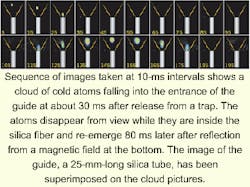Cold atoms close ranks and march toward atom optics
Researchers at the University of Sussex (Brighton, England) are training neutral atoms to perform close-order drill while remaining cool and following detailed instructions as if they were electrons or photons. The ultimate goal is generally referred to as integrated atom optics, in which the controlled flow of neutral atoms along well-defined paths, as well as the interactions among those atoms, might form the basis of a new technology (see image).
There are several aspects of the research that make it interesting, according to Ed Hinds, a professor at the Sussex University Centre for Optical and Atomic Physics. One aspect has to do with manipulating cold atoms on a micrometer or even nanometer scale to perform tasks similar to the integrated circuitry used for computing. Another interesting area has to do with quantum-mechanical effects of the single-mode propagation of neutral atoms that are analogous to the single-mode propagation of light.
"In old-fashioned optics, the propagation of light consisted of straight lines, geometrical optics, and the kind of things that Newton did," Hinds said. "In this century, wave propagation of light has been very important for building modern optical devices. So on the subject of manipulating atoms, we've already had what you might call geometrical atom optics for some time. And we're trying to use the waviness of the atoms to do something analogous to wave optics." Instead of the conventional geometrical herding of atoms into an atomic beam, Hinds envisions the highly disciplined atomic wave motion that might produce an atom interferometer.
A third area of interest for the Sussex team has to do with the physics of cold gases. The researchers would like to ask and answer questions such as, "What are the physical properties of a gas that is cold enough to be a condensate in three dimensions but is constrained to move only along one dimension?"
To train their neutral atoms to perform single-mode maneuvers on command, Hinds and his colleagues surround the atoms with four columns of tightly packed electrons. The electrons flow through four parallel wires that are maintained at a constant distance from each other by the glass of an optical fiber. The wires run through holes along the length and near the periphery of the fiber that form a square pattern in the fiber cross section. The electrical current flowing through the parallel wires sets up a strong magnetic field that induces the neutral atoms to depart their traditionally amorphous cloud structure and file down a fifth column at the hub of the optical fiber, flanked by the four columns of electrons.
The strength of the magnetic guiding force increases in proportion to the square of the inverse of the distance between the electrical currents. So the trick has been to get the wires very close together. The distance between adjacent wires on each side of the square was 522 µm in an early version of the work.1 Further work has decreased the diameter of the fiber by an order of magnitude.
"Having a strong force means having a very tight track for atoms," Hinds said. "It means that the energy needed to excite an atom from the lowest quantum state to the first excited state is bigger. The stronger the force is, the more energy it requires to push an atom out of the lowest quantum state to a higher vibrational state. And making that energy bigger is good, if you're aiming toward a single mode or a small number of modes."
The atom guide was fabricated by researchers at the University of Southampton Optoelectronics Group, which had originally invented a multihole fiber for a fiberoptic communications channel, Hinds said. In addition to making the guides smaller, the Sussex group is also seeking a brighter source of atoms. And they have decided to try the already cool and well-disciplined atoms from a Bose-Einstein condensate as a source instead of the relatively ragtag output of their current magneto-optical trap.
"What we're talking about is analogous to a single-mode optical fiber," he said. "If you try to fill it with light from a candle, it's a hard job, but if you have a laser then it's feasible. The atoms in the Bose-Einstein condensate are like the light in a laser. And that's ultimately what you need: an atom laser to load the fiber."
REFERENCE
- M. Key et al., Phys. Rev. Lett. 84(7), 1371 (Feb. 14, 2000).
About the Author
Hassaun A. Jones-Bey
Senior Editor and Freelance Writer
Hassaun A. Jones-Bey was a senior editor and then freelance writer for Laser Focus World.
